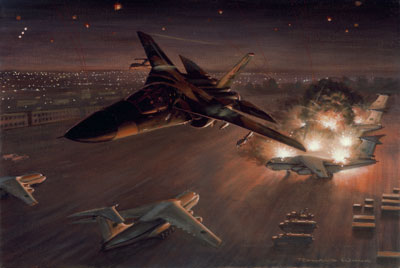Operation El Dorado Canyon by Ronald Wong
F-111F
Unit: 493rd TFS, 48th TFW, USAF
Serial: LN/30451
This aircraft took part in airstrike against Tripoli, Libya in 1986.
Following a series of terrorist attacks on America in 1986, US intelligence agencies claimed that they had “incontrovertible” evidence that the incidents had all been sponsored by Libya. The Operation El Dorado was America’s response to this growing terror threat. This operation involved a British based-USAF mission to lead a bombing mission, even longer than the Black Buck Raids of 1982. The logistics of the missions were further complicated when France, Italy, Germany and Spain refused to co-operate with the US. Only UK was willing to give to the USAF some territory to serve as a base.
The bomber chosen for his mission was extremely fast, low flying F-111. Though it was a very advanced bomber, it had never built keeping such long missions in mind. Operation El Dorado Canyon would involve a round trip of 6400 miles, taking 13 hours and requiring no less than twelve in-flight refuelings, for each of the 24 F-111s. It was an ambitious mission with almost no room for error.
The targets were finalized after a joint planning with the USAF and USN. There were two targets in Benghazi, a terrorist training center and an airfield. There were three other targets in the city of Tripoli, which was a terrorist Naval training camp, the Wheelus AFB and the Azziziyah Barracks.
The 24 F-111s left British soil on April 14th, 1986. Six of them were spare aircraft who returned later on. The US Navy initiated a simultaneous attack in A-6E bombers and the F-18 Hornet. Though the strikes were successful and resulted in severe damage on key Libyan targets, it wasn’t an easy mission. The Libyan Air Defense was a state-of-the-art system virtually at par with that of Soviet technology.
Of the 18 F-111s that headed for Libya, five had aborted the mission, so the number dwindled down to 13, who finally reached Tripoli. The Azziziyah Barracks was hit by three of the bombs, while one bomb hit the Sidi Balai terrorist camp. Two others hit the Tripoli airport and destroyed many grounded aircraft.
The attack was over in just over ten minutes and the twelve F-111 turned around for the long flight back to British soil. One of the bombers was lost in the raid, possibly hit by a surface-to-air-missile and its crew killed.
The raid was considered a success. It did not topple Gadaffi, but it did put an end to the Libyan sponsored terror attacks on the US.
